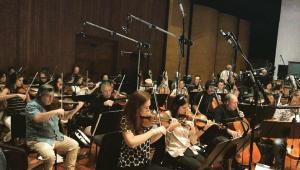Viewpoint: Star Wars at the Dome
 George Lucas is a fan. I don't mean of Star Wars (though he is, I suspect, that, too); rather, he's a fan of digital cinema. And he wanted his magnum opus, Star Wars III: Revenge of the Sith, to play in digital on the biggest screens in the world. That covers a lot of territory, but the screen at the Cinerama Dome in Hollywood, which measures 32 by 86 feet, just might be the biggest anywhere.
George Lucas is a fan. I don't mean of Star Wars (though he is, I suspect, that, too); rather, he's a fan of digital cinema. And he wanted his magnum opus, Star Wars III: Revenge of the Sith, to play in digital on the biggest screens in the world. That covers a lot of territory, but the screen at the Cinerama Dome in Hollywood, which measures 32 by 86 feet, just might be the biggest anywhere.
The Dome was originally built for Cinerama (you probably figured that out), but not the original 3-strip Cinerama. That format used three separate film elements and three projectors to fill its immense screen. By 1963, when the new geodesic structure went up on Sunset Boulevard in all of 16 weeks, Cinerama had abandoned the expensive 3-strip process in favor of a single 70mm print. The first 70mm Cinerama film to play there was It's a Mad, Mad, Mad, Mad World.
When the Dome reopened a couple of years ago after a much-needed refurbishing, it was part of a bigger facility that now includes an adjoining multiplex. The entire complex is now called the Arclight Cinemas, one of LA's premier movie destinations.
The upgrade to the 800-seat Dome was more than just cosmetic, and the theater retained its ability to show 70mm films as well as 35mm. The latter dominates its current schedule, but 35mm prints are too small for the best results on such a large screen. They often produce a slightly dim and soft—though big—image. During its renovation, the Dome also added the equipment needed to show the old, 3-strip Cinerama films. It has since done so, but infrequently and only for short, special-event runs.
A few blocks north of the Dome, the old Warner theater was the original LA venue for 3-strip Cinerama presentations back in the 1950s and early 1960s. It is now a private theater that houses the Digital Cinema Laboratory (DCL) which is run by the Entertainment Technology Center of the University of Southern California. This research facility, dedicated to the improvement of digital theatrical presentations, currently provides the best-quality digital projection in town, and very possibly anywhere. But it is not open to the public. The Dome's updated sound system uses JBL speakers, including 44 computer-placed surrounds. The acoustics were improved with sound-absorbing materials on the ceiling, reducing (but not eliminating) a slightly reverberant acoustic that some moviegoers found distracting. The new sound system is a little too forward and aggressive for my tastes, aggravated by a presentation that can often be uncomfortably loud.
The Dome's upgrade did not include a digital projector, even though they've been available since 1999, when Star Wars I: The Phantom Menace premiered. The screen was simply too large for the early digital projectors. But with 2K and higher-resolution projectors now becoming available, there are enough pixels to make sense on a large screen. The Dome's digital projector is a 2K DLP (2K refers to the horizontal resolution). With each pixel about half an inch wide, some may argue that 2K is still not enough. The Mann Village in Westwood, another of the few remaining LA theaters with a very large auditorium and screen, also has a 2K digital projector.
Fortunately, the Arclight Cinema has reserved seating in all of its theaters. It took me about a week to get a reservation in the middle of the first row of the mezzanine—in my opinion, one of the best seats in the house. You look straight out at the screen from there; in the lower level you look up at the screen. In either case, its deep curvature causes some image distortion, but it's far less noticeable from the higher seating position.
How did the Dome's digital presentation of Revenge of the Sith look? On the plus side, the image was almost as crisp and bright as the best 70mm presentations I've seen on the same screen. But you really need even more light and more pixels for the best results with an image that large. I was never aware of the pixel structure, but am certain that I would have been from a closer seat.
The big limitation was contrast ratio. At its best, digital cinema can approach the contrast ratio of film, but it isn't quite there yet. The best home-oriented digital projectors are better in this respect, largely because they don't have to sacrifice black levels for brightness. But the contrast on the Dome's screen was definitely inferior to the best I've seen at other commercial digital presentations. Why? Because the deep curvature of the screen plagues even film presentations in this respect. Light reflecting from one side of the screen actually travels across to the other side and washes out the image there. Digital projection needs all the help it can get to reach a satisfactory contrast ratio, and this self-reflection doesn't help. (In the early years, many Cinerama theaters got around this with a screen made up of hundreds of individual vertical stripes, each aimed in a way to minimize cross reflections. The Dome has a solid screen.)
The sound was fine for a big theater, though even the best theaters today often can't equal the sound available in a good home theater system.
Despite my reservations about the film itself (you can read about them in my review on the next page, but be forewarned —it's full of spoilers!), I'll likely see it again in a different digital theater, just to check out the technical differences. That theater will most likely be the Mann Village in Westwood, CA (where the LA premier of Revenge was held; see news story). In addition to its new digital projector, the Mann Village has the best subwoofers in town. Though for my money, the best-sounding theater overall in LA remains the Mann National in Westwood, just blocks from the Village.
- Log in or register to post comments































































